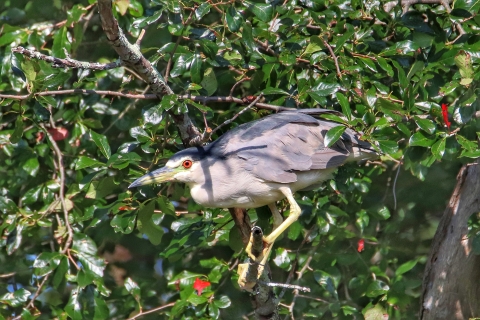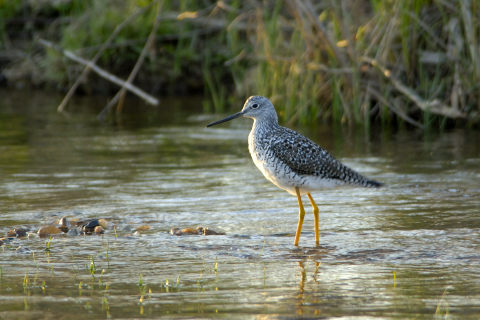Lido Beach Wildlife Management Area is only open to select public use activities (e.g., biological research, environmental education) by Special Use Permit.
Visit Us
This refuge unit is only open to select public use activities (e.g., biological research, environmental education) by Special Use Permit.
Location and Contact Information
- Lido Beach Wildlife Management AreaView DetailsLido Boulevard Lido Beach, NY 11561
About Us
Obtained by the Service in 1969, Lido Beach Wildlife Management Area was a former Nike missile site. Lido Beach is located on the bay side of Long Beach a barrier island, west of Jones Inlet in Nassau County, Long Island. Lido Beach is almost entirely tidal wetland, with 22 acres of saltmarsh and shrub thickets. The unit has a high diversity of shorebirds and wading birds. Wintering waterfowl such as American black duck and Atlantic brant also use the tidal wetlands. Lido Beach supports nesting clapper rails, black-crowned night-heron, osprey and saltmarsh sharp-tailed sparrow. Management efforts focus on wetland restoration and invasive species invasive species
An invasive species is any plant or animal that has spread or been introduced into a new area where they are, or could, cause harm to the environment, economy, or human, animal, or plant health. Their unwelcome presence can destroy ecosystems and cost millions of dollars.
Learn more about invasive species control.
Aquatic Habitats
Lido Beach is part of the Hempstead estuary, which is noted for its impressive concentrations of waterfowl, long-legged waders, terns, and shorebirds. Hempstead Bay is one of the largest undeveloped coastal wetland ecosystems in New York. Although small in size and forming only a modest portion of the Bay, Lido Beach provides important habitat for wetland-dependent wildlife.
The Hempstead Harbor is known for its concentrations of shorebirds during migration. Plovers and sandpipers are commonly observed at Lido Beach. Occasionally, such shorebird species as whimbrels, marbled godwits, and pectoral sandpipers may be observed in the management area. Willets nest there in early summer, and glossy ibis have been sighted roosting on the piles of dredge spoil.
Tidal Wetlands
The Wildlife Management Area consists primarily of tidal wetland. The diversity of shorebirds and wading bird is high, as is the use by waterfowl, particularly black ducks and Atlantic brant in winter. The area supports nesting clapper rails, black-crowned night herons and osprey, as well as numerous songbirds such as sharp-tailed sparrows. Its location on a barrier island makes it an excellent habitat for migrating songbirds and raptors.
The marsh at Lido Beach is a typical mixture of salt hay and salt grass; some black grass, glassworts, and smooth cordgrass also are present. Approximately 45 percent of Lido Beach is ditched high salt marsh salt marsh
Salt marshes are found in tidal areas near the coast, where freshwater mixes with saltwater.
Learn more about salt marsh . That ditching is deep, and well-flushed by daily tides. Two mudflats on the marsh are being pioneered by glasswort species. The mud flats provide an excellent foraging area for a variety of shorebirds.
What We Do
Wildlife conservation is at the heart of the National Wildlife Refuge System. It drives everything on U.S. Fish and Wildlife Service lands and waters managed within the Refuge System, from the purposes for which a national wildlife refuge national wildlife refuge
A national wildlife refuge is typically a contiguous area of land and water managed by the U.S. Fish and Wildlife Service for the conservation and, where appropriate, restoration of fish, wildlife and plant resources and their habitats for the benefit of present and future generations of Americans.
Learn more about national wildlife refuge is established to the recreational activities offered to the resource management tools used. Using conservation best practices, the Refuge System manages Service lands and waters to help ensure the survival of native wildlife species.
Refuges deploy a host of scientifically sound management tools to address biological challenges. These tools span active water management to wilderness character monitoring, all aimed at ensuring a balanced conservation approach to benefit both wildlife and people. At this field station our conservation tool box includes:
Invasive Species
Invasive plants are a threat because they displace native plant and animal species, degrade wetlands and other natural communities, and reduce natural diversity and wildlife habitat values by out-competing native species for light, water, and nutrients. Invasive plants do occur on the refuge and threaten both aquatic and terrestrial systems.
Once invasive plants have become established, their characteristic abilities to establish easily, reproduce prolifically, and disperse readily make getting rid of them expensive and labor-intensive. Many of them cause measurable economic impacts, particularly in agricultural fields. Preventing new invasions is extremely important for maintaining biodiversity and native plant populations. Controlling affected areas requires extensive partnerships with adjacent landowners and state and local government agencies.
Our Species
Black-crowned Night Heron
These herons can be found using the refuge to feed, roost and nest. Most sightings occur when the birds are flying or roosting in trees and shrubs. When the water levels are low and fish are abundant, the birds’ tactic for feeding is to stalk their prey – standing motionless in or along the water’s edge waiting for fish to come within reach to grasp it in their sharp-edged bill. They are nocturnal and feed primarily during crepuscular periods (dawn and dusk).
Yellowlegs
Yellowlegs are wading shorebirds which actively pursue their prey. Greater yellowlegs have a longer bill than the lesser yellowlegs and it appears slightly upturned. During the late spring and late summer, shorebirds like the greater yellowlegs stop at Lido Beach Wildlife Management Area to take advantage of mudflat habitat. The greater yellowleg along with other shorebird species will pick over these mudflats feeding on small aquatic and terrestrial invertebrates.
Projects and Research
Current Projects Include
Refuge staff and Student Conservation Association interns complete saltmarsh vegetation surveys at Wertheim, Seatuck, and Lido Beach each August and September. The team surveys 203 one-meter square quadrats to assess how the salt marsh salt marsh
Salt marshes are found in tidal areas near the coast, where freshwater mixes with saltwater.
Learn more about salt marsh is responding to restoration efforts. During the surveys, the team records percent cover, stem density, and stem height. Hurricane Sandy resiliency projects involve the use of coir logs to fill former mosquito ditches, newly excavated channels to improve tidal flow, thin layer deposition, and a new living shoreline.























